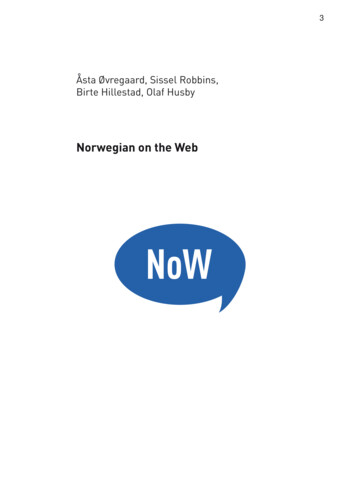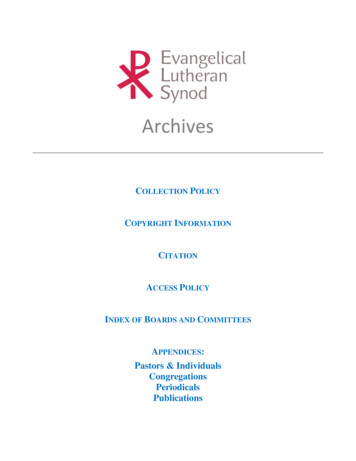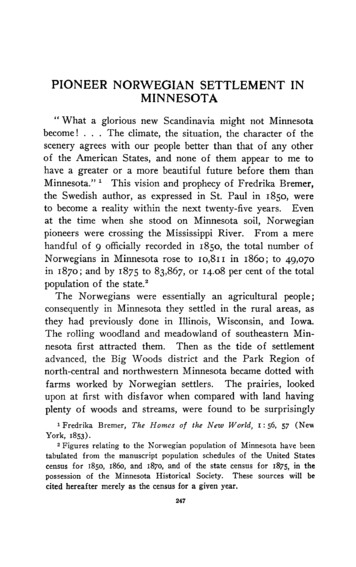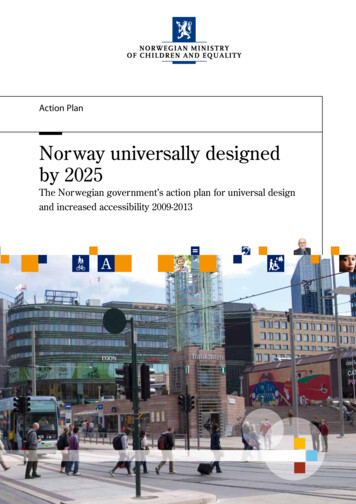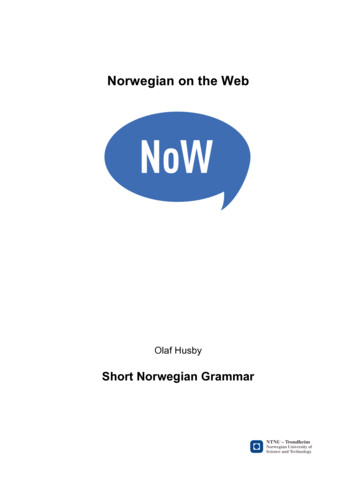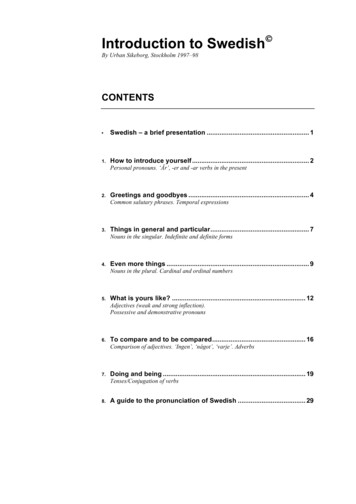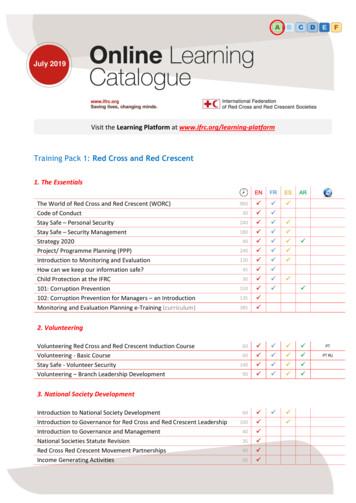
Transcription
LearnNorwegianon the WebTextbookOlaf Husby, Åsta Øvregaard,Kjell Heggvold Ullestad, Dominique Heyler
Trondheim, 10.06.2013, revidert 10.02.2014
LearnNoW - by NTNU for Vox3Table of Contents1 The Vidal family . 54 The Neighbourhood . 351A Alex . 51B Benjamin . 51C Cecilie . 61D Dina . 6Grammar . 74A Hos mormor og morfar . 354B Bens morgen . 364C Cecilie sender en pakke . 364D Veien til skolen . 37Grammar . 38WORD ORDER . 7QUESTION WORDS . 7NATIONALITIES. 8VERBS . 38QUESTION WORDS . 39Pronunciation . 8The Norwegian alphabet . 8The Norwegian and English letters compared . 9Extras . 101.1 Names . 101.2 Greeting . 111.3 Verbs . 111.4 How to say hv-. 111.5 Pronouns . 122 Arriving in Norway . 132A Fra Paris til Oslo . 132B På Gardermoen . 142C Passkontroll . 152D Hei, pappa! . 16Grammar . 17PRONOUNS . 17VERBS . 17NOUNS . 18WORD ORDER . 18CONJUNCTIONS. 19PREPOSITIONS. 19Pronunciation . 39Norwegian consonants . 39Silent letters . 40Extras . 414.1 Family words . 414.2 The time . 424.3 The time . 424.4 Ordinals . 424.5 Dates . 435 New friends . 445A Katten . 445B Fotball . 455C I butikken . 465D To nye venninner . 47Grammar . 48PRONOUNS . 48ADJECTIVES . 49ADVERBS . 49PREPOSITIONS . 50Pronunciation . 52Norwegian consonants. 52Some consonant clusters . 52Pronunciation . 19Extras . 54Norwegian vowels . 19The Norwegian and English vowel letters compared . 205.1 Colours . 545.2 Regions in Norway. 545.3 Food and drink . 555.4 Rooms . 555.5 Ut, ute, utenfor . 56Extras . 212.1 Numerals . 212.2 Numerals 40 . 212.3 En, ei, et (a/an). 222.4 To go . 222.5 Nationalities – extended list . 233 A new home. 253A Alex våkner i Fjordvik . 253B Flyttebilen kommer . 263C Hjemme. 273D Dinas rom. 28Grammar . 29PRONOUNS . 29VERBS . 29NOUNS . 30WORD ORDER . 316 A trip to town . 576A Frokost . 576B I byen . 586C Salg. 596D På kafé . 60Grammar . 62PRONOUNS . 62VERBS . 62ADJECTIVES . 63Pronunciation . 64Pronunciation . 32Norwegian prosody . 64Long or short vowels . 64Stress . 65Word tones . 66Norwegian diphthongs . 32Extras . 66Extras . 326.1 Bathroom . 666.2 Shopping centre . 666.3 Clothes . 676.4 Spare time - expressions . 673.1 The Days. 323.2 Furniture . 333.3 Kitchen . 333.4 Buildings . 333.5 Foreigner – foreign . 34
4LearnNoW - by NTNU for Vox7 Everyday life . 6810 Illness, health and sports . 1027A Alex våkner tidlig. 687B På kontoret . 697C Om barnehagen . 707D Første dag på skolen . 71Grammar . 7110A Alex har feber . 10210B Hjemme med sykt barn. 10310C Cecilie skal på kurs . 10410D Dina spiller håndball . 106Grammar . 107VERBS . 71NOUNS . 73WORDS FOR QUANTITIES . 74Retroflex sounds . 75PRONOUNS . 107ADJECTIVES . 108ADVERBS . 111PREPOSITIONS . 111SYNES - TRO - TENKE . 112Extras . 76Pronunciation . 112Pronunciation . 757.1 Verbs 1 & 2. 767.2 Verbs 3 & 4. 777.3 Irregular verbs . 777.4 Time expressions. 778 School and leisure . 788A Dina henter Alex . 788B På norskkurs . 798C En fin høstdag . 808D Et friminutt . 81Grammar . 82VERBS . 82ADJECTIVES . 85WORD ORDER . 86Pronunciation . 87Reductions . 87Extras . 888.1 Regular verbs . 888.2 Classroom vocabulary . 898.3 Irregular verbs . 898.4 Begge - både (both) . 909 Work . 919A Barnehagen drar på tur . 919B Et nytt prosjekt. 929C Fjordvik sykehus . 939D Klasseavis . 94Grammar . 95PRONOUNS . 95NOUNS . 96WORD ORDER . 97Pronunciation . 98Connected speech . 98Extras . 999.1 Compound nouns . 999.2 Som (that) .1009.3 Phrasal verbs .1009.4 Ikke heller (not either) .1019.5 Health care in Norway .101No pauses at all? . 112Extras . 11310.1 Illness . 11310.2 Weather, months, seasons . 11310.3 Å synes - å tro (think) . 11510.4 Adverbs from adjectives . 11510.5 How often?. 11510.6 Body . 11611 Culture and leisure. 11711A Skomakerdokka . 11711B På hyttetur . 11811C En invitasjon til Oslo. 11911D Justin Bieber-konsert . 120Grammar . 121FORDI - DERFOR . 121SÅ . 122SHORT ANSWERS . 122JA - JO . 123Pronunciation . 124Speech rhythm . 124Unstressed syllables . 124Rhythm unit: The foot . 125Extras . 12611.1 Ja - jo (yes). 12611.3 Two Norwegian painters . 12611.4 At - om (that - if). 12711.5 Skomakerdokka . 12812 Holidays and festivals . 12912A Lek i snøen . 12912B Ben tar imot gjester . 13012C Julemiddag . 13112D Julegaveåpning . 132Grammar . 133VERBS . 133WORD ORDER . 134COMMA RULES . 135Pronunciation . 136Initial unstressed syllables . 136Summary. 136One last hint . 137Extras . 13712.1 Words for snow . 13712.2 Det (it) . 13812.3 Man (one). 13812.4 Easter and 17 May. 138
LearnNoW - by NTNU for Vox1 The Vidal familyWhat to learn Introducing oneselfMaking simple statementsMain grammar Basic word orderQuestion word1A Alex- Hei! Jeg heter Alex. Hva heter du?This is Alex. He is 5 years old. He is travelling from Paris to Oslotogether with his mother and sister. They are moving from Franceto Norway. His father is already in Norway. He is waiting for themthere.Vocabularydu youhei hiheter (å hete) (v) am/is/are namedhva whatjeg Iv verb1B Benjamin- God dag! Jeg heter Benjamin Vidal. Hyggelig å hilse på deg!This is Benjamin Vidal. He is French, but he is living in Norway now.His wife is Norwegian. Her name is Cecilie. They have two children,Alex and Dina.Vocabularyen dag (n) a daygod (a) goodå hete (v) to be namedå hilse (v) to greethyggelig (a) nice, pleasanthyggelig å hilse på deg! (a) nice to meet youpå (p) on, atå (infinitive marker) ton noun, v verb, a adjective, p preposition5
6LearnNoW - by NTNU for Vox1C Cecilie- Hallo! Jeg heter Cecilie Hansen Vidal. Jeg er norsk. Er du norsk?This is Cecilie Hansen Vidal. She has been living in France for manyyears with her husband, Ben, and their two children. Now they aremoving to Fjordvik* in Norway. Her parents live there. Ben iswaiting for his family at the airport. He went in advance to find ahouse for them.Vocabularyer (å være) (v) am, are, ishallo hellonorsk (a) Norwegianv verb, a adjective*Fjordvik is a fictional town.1D Dina- Hei! Jeg heter Dina. Jeg kommer fra Frankrike. Hvor kommerdu fra?This is Dina. She is 14 years old. Now she has left all her friends inFrance to move to Norway with her family. She is looking forward tosee her dad again, though. He has been away for some weeks,working in his new job in Fjordvik.Vocabularyfra (p) fromFrankrike (n) Francehvor wherekommer (å komme) (v) come(s)n noun, v verb, p preposition
LearnNoW - by NTNU for Vox7GrammarWORD ORDERMain clauses (sentences)A Norwegian sentence must always have a verb and a subject. The subject is the person or thingcarrying out the action in the sentence.The normal word order in a main clause is:subject - verb - rest of the sentenceJeg heter Alex. I am called Alex.Jeg kommer fra Frankrike. I come from France.QuestionsIn questions with question words the verb is also the second element:Hva heter du? What is your name?In questions without a question word the sentence starts with the verb:Er du norsk? Are you Norwegian?QUESTION WORDSThe most common question words are:hvawhathvemwhohvorwhere (how)hvordanhowExamples:Hva heter du?What is your name?Hvem er det?Who is it?Hvor bor du?Where do you live?Hvordan går det?How are you?The question word hvor is used for how when we ask about a size or a quantity.Hvor gammel er du?How old are you?
8LearnNoW - by NTNU for nLanguageEnglandengelsken engelskmannengelskFrankrikefransken franskmannfranskItaliaitaliensken italieneritalienskNederlandnederlandsken nederlendernederlandskNorgenorsken nordmannnorskPolenpolsken polakkpolskSpaniaspansken spanjolspanskTysklandtysken tyskertyskUSAamerikansken amerikaner(amerikansk) engelskPronunciationThe Norwegian alphabetThe Norwegian alphabet contains 29 letters, 9 vowels and 20 -U-V-W-X-Y-Z-Æ-Ø-ÅBelow you will find each letter in upper and lower case as well as the pronunciation of the Norwegian«name» of the letter. The pronunciation is given with reference to The International PhoneticAlphabet, IPA. A colon after a vowel indicates a long speech sound. Absence of colon after the vowelindicates a short speech sound, cf. the long vowel /e:/ used to name the letter, and the short vowel/e/ in /ef/, to name the letter.Below, brackets, , surround symbols that are to be regarded as letters, while slashes, / /, surroundsymbols that indicate speech sounds.ABCDEFGHIJabcdefghij/ɑː/ /beː/ /seː/ /deː/ /eː/ /ef/ /geː/ /hoː/ /iː/ /jeː/KLMNOPQRSTklmnopqrst/koː/ /el/ /em/ /en/ /uː/ /peː/ /kʉː/ /ær/ /es/ /teː/
LearnNoW - by NTNU for Vox9UVWXYZÆØÅuvwxyzæøå/ʉː/ /veː/ /2dobeltˌveː/ /eks/ /yː/ /set/ /æː/ /øː/ /oː/The three last letters, the vowels æ, ø, å are rare among languages that are using the Latinalphabet. If necessary, users of foreign keyboards can replace each of them with a combination oftwo vowel letters: æ - ae «sær» «saer» weird ø - oe «sør» «soer» south å - aa «sår» «saar» wound, soreOf the remaining letters, c, q, w, x, z in general only occur in loanwords (camping, quiz, watt,xylofon, pizza).The Norwegian and English letters comparedBelow is a short overview comparing the pronunciation of the Norwegian alphabet compared toEnglish.The overlap between English and Norwegian speech sounds is smaller than what the list belowseems to indicate as the list only refers to the letters. There are several consonant sounds that areexpressed through consonant clusters (consequently they are not included in the alphabet, but theywill be discussed in Chapter 5). The alphabet by itself does not express the difference between longand short vowels.NorwegianEnglish referenceletteraLike a in «hard»bLike b in «buy»Before front vowels i, e, y cf. /s/ in «circus»cBefore back vowels a, o, u cf. /k/ in «camping»dLike d in «dog»eLike e in «bed»fLike f in «fine»gLike g in «girl»hLike h in «hat»iLike ee in «see»jLike y in «yes»
10LearnNoW - by NTNU for VoxNorwegianEnglish referenceletterkLike k in «kite»lLike l in «live»mLike m in «map»nLike n in «now»oNo equivalentpLike p in «pen»qIn Norwegian, qu is pronounced as /kv/, cf. «quiz» - /kvis/rLike Scottish «r». The tip of the tongue taps the alveolar ridge.sLike s in «see»tLike t in «tea»uApproximately as the final vowel in «new»vLike v in «violin»wLike v in «violin»xLike x - /ks/ in «tax»yNo equivalentzPronounced as /s/, cf. «zoom» - /su:m/æLike a in «bad»øNo equivalentåLike aw in «saw»Extras1.1 NamesNaming song for children:- Hei, hei, hei, jeg heter Alfred.- Hei, hei, hei, hva heter du?- Morn, morn, morn, jeg heter Petter.- Morn, morn, morn, hva heter du?(Repeated for all the names in the group.)Morn is short for god morgen which means good morning.
LearnNoW - by NTNU for Vox111.2 GreetingThere are several words that can be used when you are greeting another person:Hei is informal and quite common. In general one is using hei in face to face communication withfriends, but also the first time you meet a stranger.Hallo is informal and rather common as well. In general one is using hallo when talking on thetelephone, but also in face to face communication.God dag (literaly, good day) is a bit more formal, most used by adults when greeting strangersand less acquainted people.1.3 VerbsIn Norwegian, the tense of the verbs can in general be identified by checking a verb's ending. Mostverbs have -r endings in present tense.There are four different verbs in Chapter 1:Jeg heter Axel.Hyggelig å hilse på deg.Jeg er norsk.Hvor kommer du fra?Can you identify the verbs in present tense?1.4 How to say hvIn the questions words:hvawhathvorwhere (how)hvemwhohvordan howthe initial h is not an /¹vuɖɑn/
12LearnNoW - by NTNU for Vox1.5 PronounsSingularPluraljeg (I)vi (we)du (you)dere (you)1.2.3.hun (she)de (they)han (he)
LearnNoW - by NTNU for Vox132 Arriving in NorwayWhat to learn Making simple statements and questionsMaking simple negative statementsBasic travel vocabularyNumbersMain grammar Personal pronounsPresent tense of the verbWord order2A Fra Paris til OsloAlex kommer fra Frankrike. Han er fem år. Han reiser med fly fra Paris til Oslo. Han reiser sammenmed mamma og Dina. Alex snakker med ei dame. Hun er norsk.Emma:Hei. Jeg heter Emma. Hva heter du?Alex:Jeg heter Alex.Emma:Hvor gammel er du, Alex?Alex:Jeg er fem år gammel.Emma:Hvor kommer du fra?Alex:Jeg kommer fra Paris. Hvor kommer du fra?Emma:Jeg kommer fra Oslo.Alex:Jeg reiser sammen med mamma og Dina. Vi reiser til pappa. Han bor i Norge. Han venterpå oss på Gardermoen.Alex reiser med fly sammen med mamma og Dina.Foto: Norwegian ASAVocabularybor (å bo) (v) live(s)ei dame (n) a ladyei a, an, one (feminine)fem five
14LearnNoW - by NTNU for Voxet fly (n) a planegammel (a) oldhan he, himhun shei (p) in, at, onå komme (v) to comeen mamma (n) a mummymed (p) withNorge (n) Norwayog andoss usen pappa (n) a daddyå reise (v) to travelsammen (d) togetherå snakke (v) to speaktil (p) toå vente (v) to waitvi weet år (n) a yearn noun, v verb, a adjective, d adverb, p preposition2B På GardermoenBenjamin kommer fra Frankrike. Han bor i Fjordvik. Benjamin er førti år gammel. Han er gift medCecilie. Cecilie er norsk. De har ei jente, Dina, og en gutt, Alex.Nå er han på Oslo lufthavn på Gardermoen. Han sitter påen kafé. Benjamin venter på Cecilie, Dina og Alex.Ola:Unnskyld, er det ledig her?Ben:Ja, vær så god!Ola:Venter du på et fly?Ben:Ja, jeg venter på et fly fra Paris. Og du?Ola:Jeg også. Er du fransk?Ben:Ja, jeg kommer fra Paris.Ola:Jeg heter Ola. Hyggelig å hilse på deg!Ben:Takk i like måte, jeg heter Benjamin.Vocabularyenåeieneiende theydeg you (singular)det it, that, theen a, an, oneet a, anfransk (a) Frenchførti fortygift (a) marriedgutt (n) a boyha (v) to haveher (d) hereja yesjente (n) a girlkafé (n) a caféledig (a) vacantlike like, samelufthavn (n) an airportmåte (n) a wayPå Gardermoennå (d) nowogså (d) too, alsoå sitte (v) to sitså (d) sotakk thank youen takk (n) a thank youunnskyld excuse mevær (å være) (v) bevær så god! you're welcome! please! here youare!å være (v) to be, existn noun, v verb, a adjective, d adverb, p preposition
LearnNoW - by NTNU for Vox152C PasskontrollCecilie er norsk. Hun er trettiåtte år gammel. Hun er gift med Benjamin. Hun reiser fra Frankrike tilNorge sammen med Dina og Alex. Nå snakker de med en mann. Han kontrollerer pass.Mann:Er du norsk?Cecilie:Ja, jeg er norsk.Mann:Har du pass?Cecilie:Ja, her er det, vær så god!Mann:Takk. Du heter Cecilie Hansen Vidal. Hvor kommer du fra nå?Cecilie:Jeg kommer fra Paris.Mann:Bor dere i Norge?Cecilie:Nei, men vi flytter til Norge nå.Mann:Du har en gutt. Har han også norsk pass?Cecilie:Nei, han har ikke norsk pass. Han har fransk pass, her er det.Mann:OK. Du har også ei jente. Hva heter hun?Cecilie:Hun heter Dina.Mann:Hvor gammel er du, Dina?Dina:Jeg er fjorten år.Mann:Har du pass?Dina:Ja, vær så god!Mann:Takk, alt i orden. Ha det bra!Cecilie:Ha det bra!Dina:Ha det!Vocabularyalt (all) all, everythingalt i orden all right (everything in order)bra (a) fine, good, welldere you (plural)fjorten fourteenå flytte (v) to moveha det bra! goodbye!ha det! bye!ikke (d) notå kontrollere (v) to control, checken mann (n) a manmen butnei noOK okay, all righten orden (n) an orderet pass (n) a passporten passkontroll (n) a passport controltrettiåtte thirty-eightn noun, v verb, a adjective, d adverb, p preposition
16LearnNoW - by NTNU for Vox2D Hei, pappa!Benjamin står og venter. Nå kommer Dina, Alex og Cecilie. De ser pappa, og Dina roper.Dina:Hei, pappa! Her er vi!Pappa:Hei, Dina! Så hyggelig å se deg! Velkommen til Norge!Dina:Takk! Nå er vi sammen igjen, pappa.Mamma:Så hyggelig å se deg igjen. Hvordan går det?Pappa:Takk, bare bra. Hvordan går det med dere?Dina:Det går bra, men det er en lang reise. Jeg er trøtt.Alex:Jeg er også trøtt.Pappa:Ja, men nå drar vi hjem.Dina:Bra!De kjører til Fjordvik. Det tar én time.Foto: Jarle Nyttingnes / Oslo Lufthavn ASVocabularyååetåbare (d) just, onlybare bra! (d) just fine!det går bra! I'm fine!dra (v) to leavegå (v) to walk, gohjem (n) a homehjem (d) homehvordan howigjen (d) againkjøre (v) to driveååååenlang (a) longrope (v) to call, cry, shoutse (v) to seestå (v) to standta (v) to taketime (n) an hourtrøtt (a) tiredvelkommen welcomen noun, v verb, a adjective, d adverb, p preposition
LearnNoW - by NTNU for Vox17GrammarPRONOUNSPersonal pronouns - subject form1. jegI2.duyou (singular)3.hanhehunshedet/denit1.viwe2.dereyou (plural)3.detheyVERBSThe infinitiveThe infinitive marker is å (to). The infinitive marker is generally used when the verb is in the infinitive:Hyggelig å hilse på deg. Nice to meet you.Verbs in the present tenseYou add -r to the infinitive to form the present tense:InfinitivePresent tenseå kommeto come kommerå sitteto sit sitterIt does not matter who is carrying out the verb. You add -r to the infinitive form of the verb after allpronouns: I, you, he, she, it, we, you and they:Jeg kommer fra England.I come from England.Hun kommer fra Italia.She comes from Italy.Vi kommer fra Norge.We come from Norway.Note that some verbs have irregular present tense forms:å væreto be erå gjøreto do, make gjør
18LearnNoW - by NTNU for VoxStå/sitte/ligge present tenseNorwegian does not have a present continuous form like English. However, we often use the verbsstå (stand), sitte (sit) or ligge (lie) the present tense to express an ongoing action:Benjamin står og venter.Benjamin is waiting.Alex sitter og snakker med ei dame.Alex is talking to (with) a woman.The position, in which the subject is when performing the action, decides whether you should usestå, sitte or ligge.NOUNSGendersNorwegian nouns have three genders: masculine, feminine and neut
This is Benjamin Vidal. He is French, but he is living in Norway now. His wife is Norwegian. Her name is Cecilie. They have two children, Alex and Dina. Vocabulary en dag (n) a day god (a) good å hete (v) to be named å hilse (v) to greet hyggelig (a) nice, pleasant hyggelig å hilse på deg! (a) nice to meet you på (p) on, at


